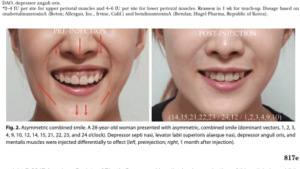
Have you ever wondered what the difference is between Botox and Dysport? If so, you are not alone! Nowadays, there are several different options on the market when it comes to neuromodulators like Botox and Dysport, and this can sometimes make it challenging to determine which one is the best one for you. Below we discuss the differences between the two, so read on to find out more!
Botox (onabotulinumtoxinA) was first approved by the FDA for cosmetic use in 2002, and since then, it has become one of the most popular ways to treat and prevent undesirable forehead lines, frown lines, and crows feet. Dysport (abobotulinumtoxinA) made its entrance into the US about 7 years later in 2009, but it was actually used throughout Europe for more than a decade prior to its FDA approval. Since Botox has been around for longer, it is oftentimes used as a bit of an “umbrella term” for most of the neuromodulators on the market these days.
While there are other options to consider, Botox and Dysport are largely considered the most effective. Knowing which one is better for you boils down to understanding what each one does, how they’re different, and what results you are looking to achieve.
Before we discuss the differences between the two products, let’s first cover some of the similarities.
Both Botox and Dysport are effective options for treating dynamic lines and wrinkles, which refers to the wrinkles that form as a result of muscle movement. With consistent use, they have even been shown to help soften static wrinkles, or lines that are present at rest. The most popular areas that are treated are the frown lines, forehead lines, and lines around the eyes, but there are many other areas where neuromodulators can be used. For example, both are great for treating hyperhidrosis, or excessive sweating.
So what about the differences?
Perhaps the biggest difference to note between Botox and Dysport is the amount of units required for treatment. Dysport has a different dilution than Botox, which means you can expect to receive roughly 3 times the amount of Dysport units as Botox units for any given area treated. In other words, 3 units of Dysport is the equivalent to about 1 unit of Botox.
If you’re worried that Dysport will cost more – don’t be! The pricing takes this difference into consideration, so the bottom line is the same.
Another key difference is that Dysport is composed of smaller molecules than Botox, giving it a larger area of spread once it’s injected and oftentimes a bit of a “softer” look. So if you’re treating a large area, like the forehead, Dysport is oftentimes a good choice given that it spreads out more, but Botox might be preferred for smaller areas, such as around the eyes.
Finally, the length of time it takes for each one to take effect is somewhat different between the two. After injection, it generally takes Botox about 7 days to start working, although Dysport typically starts working 1-3 days post-injection. Both are considered to have their full effect at 2 weeks.
The effects of both Botox and Dysport can last anywhere from 2-6 months, depending on the area treated and how much is required to relax the muscle. After about a year of treatments, you can often go longer between treatments because it takes less effort for those muscles to relax.
So there you have it! Hopefully this explanation has helped to clarify some of the similarities and differences between Botox and Dysport.
If you have any questions or would like to book a consultation or treatment with one of our providers, please give us a call. Feel free to connect with Nuveau Plastic Surgery for Dysport and the best Botox treatment in Houston, TX.
Stay smooth, my friends!

